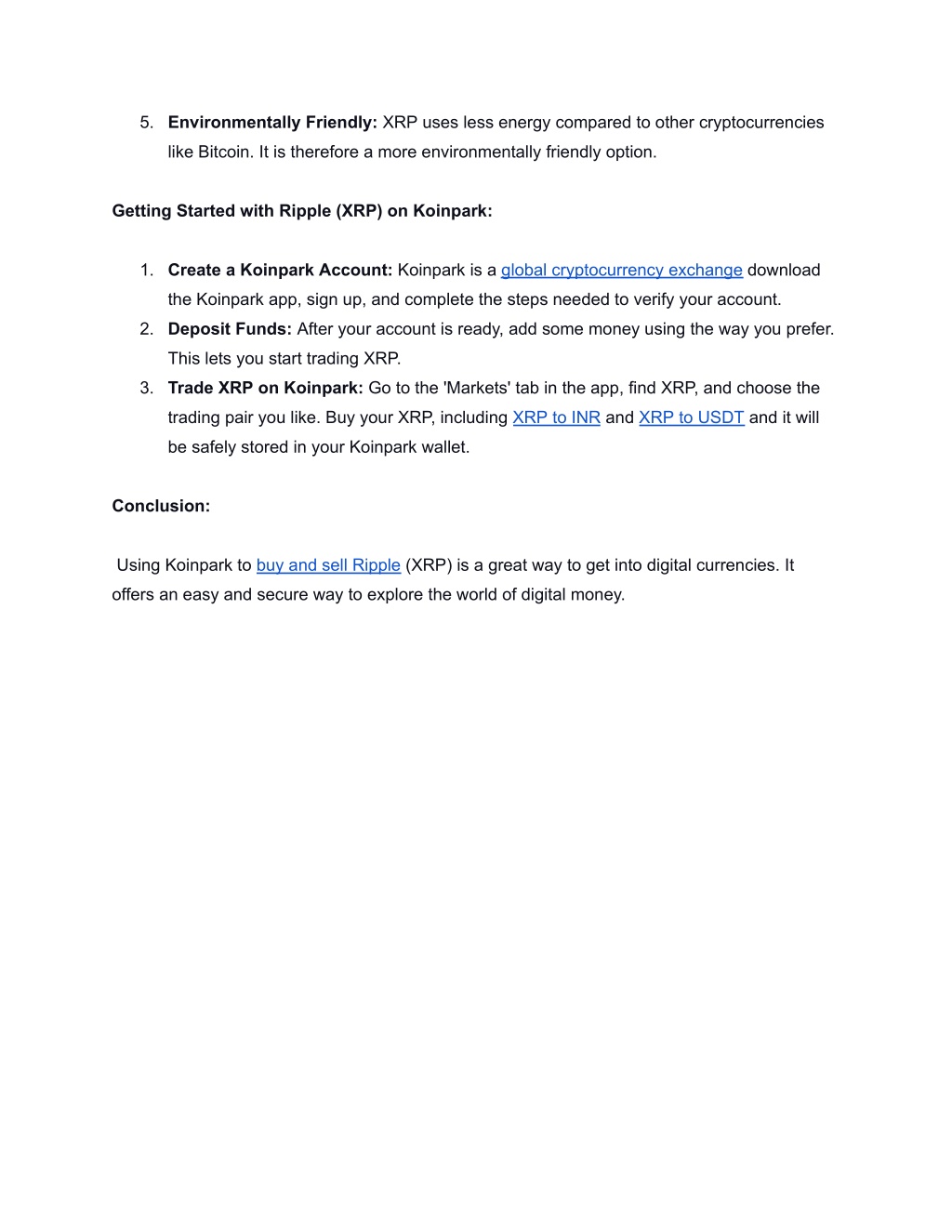Understanding XRP: Uses, Benefits, And Risks

Table of Contents
XRP, the native cryptocurrency of Ripple Labs, has emerged as a significant player in the rapidly evolving world of digital assets. While often grouped with other cryptocurrencies like Bitcoin and Ethereum, XRP boasts unique features and functionalities that set it apart. This comprehensive guide will delve into the uses, benefits, and risks associated with XRP, providing you with a well-rounded understanding of this intriguing digital asset. We'll explore XRP's potential as a revolutionary payment solution and analyze the factors that contribute to its volatility and regulatory scrutiny.
Uses of XRP
XRP's primary function is facilitating fast and efficient cross-border payments, but its potential applications extend far beyond this core use case.
Cross-border Payments
XRP facilitates fast, low-cost international money transfers, offering a compelling alternative to traditional methods like SWIFT.
- Reduces transaction fees: Compared to traditional methods, XRP significantly reduces the fees associated with international transfers, making it more accessible to individuals and businesses.
- Faster settlement times: XRP transactions settle near instantly, drastically reducing the processing time compared to days or even weeks with traditional banking systems. This speed is a crucial advantage for businesses needing quick and reliable international payments.
- Increased transparency: XRP transactions are recorded on a public ledger, enhancing transparency and traceability throughout the payment process. This increased visibility can help reduce fraud and improve accountability.
- Access to global markets: XRP provides businesses and individuals with easier access to global markets, streamlining international trade and commerce.
RippleNet, Ripple's payment network, leverages XRP to provide its payment solutions. The speed and efficiency of XRP transactions on RippleNet are significantly faster than SWIFT, the dominant system for international bank transfers. This speed advantage translates into reduced operational costs and improved customer satisfaction.
Liquidity Solutions
XRP can be used to provide liquidity in different currency pairs on various cryptocurrency exchanges. This functionality is particularly valuable in facilitating efficient trading between fiat currencies and cryptocurrencies.
- Facilitates faster and more efficient trading: XRP's speed and low transaction costs improve the efficiency of trading across different currency pairs.
- Reduces slippage: By bridging the gap between different markets, XRP can minimize the difference between the expected price and the actual execution price of a trade (slippage).
- Improves price discovery: The increased liquidity provided by XRP contributes to more accurate and efficient price discovery in the cryptocurrency market.
XRP's unique properties, including its speed and low transaction fees, make it an ideal asset for bridging the gap between fiat currencies and cryptocurrencies, thereby improving the liquidity and efficiency of trading on exchanges.
Other Potential Uses
While its use in cross-border payments and liquidity solutions is well-established, XRP also holds potential in several emerging areas:
- Potential for use in supply chain management: XRP's transparency and traceability features could revolutionize supply chain management by providing real-time visibility into the movement of goods.
- Integration with other blockchain platforms: The interoperability of XRP could facilitate seamless communication and transactions between different blockchain networks.
- Expansion into new markets and applications: As the technology evolves, new applications for XRP are likely to emerge, broadening its utility and potential value.
These potential applications of XRP remain largely unproven, but they highlight the broader technological possibilities of this digital asset.
Benefits of Investing in XRP
While investing in any cryptocurrency carries inherent risk, XRP presents several potential benefits for investors.
Potential for High Returns
XRP's price volatility offers the potential for significant gains, but it's crucial to remember that high risk accompanies high reward.
- Historically seen periods of substantial price appreciation: XRP has experienced periods of significant price increases in the past.
- Growing adoption by financial institutions: Increased adoption by financial institutions can lead to higher demand and price appreciation.
- Positive market sentiment can lead to price increases: Positive news and developments surrounding XRP can drive up its price.
However, it's crucial to understand that factors such as market sentiment, regulatory developments, and overall market conditions can significantly influence XRP's price. The cryptocurrency market is notoriously volatile, and XRP is no exception.
Low Transaction Fees
XRP boasts significantly lower transaction fees compared to other cryptocurrencies and traditional payment methods.
- Cost-effective for high-volume transactions: The low fees make XRP an attractive option for businesses and individuals conducting many transactions.
- Accessibility for users with limited funds: Lower fees improve XRP’s accessibility for those with limited capital.
- Reduced overall transaction costs: Lower fees translate into lower overall costs, making it more economically viable for various applications.
| Payment Method | Average Transaction Fee | Transaction Speed |
|---|---|---|
| SWIFT | $10 - $50+ | 3-5 business days |
| XRP | ~$0.0001 - $0.01 | Seconds to minutes |
This table showcases the significant cost advantages of XRP compared to traditional methods like SWIFT.
Fast Transaction Speeds
XRP transactions are significantly faster than traditional banking systems and many other cryptocurrencies.
- Near real-time settlement: XRP transactions settle almost instantly.
- Faster than many traditional banking systems: This speed advantage is a significant benefit for businesses and individuals requiring quick payments.
- Improved efficiency for businesses and individuals: Faster transactions lead to improved efficiency and reduced wait times.
The near real-time settlement of XRP transactions provides a considerable speed advantage over traditional banking systems and other cryptocurrencies, enhancing efficiency and reducing delays.
Risks Associated with XRP
While XRP offers potential benefits, it's crucial to acknowledge the inherent risks involved.
Regulatory Uncertainty
The regulatory landscape surrounding XRP remains uncertain, posing a significant risk to investors.
- Ongoing legal battles: The ongoing SEC lawsuit against Ripple creates uncertainty about XRP's future regulatory status.
- Potential for regulatory changes: Changes in regulations could negatively impact XRP's price and adoption.
- Uncertainty about future regulatory approval: The lack of clear regulatory guidelines adds to the risk associated with investing in XRP.
The SEC lawsuit against Ripple and its potential outcomes are significant factors affecting the regulatory landscape surrounding XRP and influencing investor sentiment.
Price Volatility
XRP’s price is highly volatile, subject to significant fluctuations.
- Subject to market fluctuations: XRP's price is influenced by various factors, including market sentiment, news events, and overall market trends.
- Potential for substantial price drops: The volatile nature of XRP increases the risk of significant losses for investors.
- Requires careful risk management: Investors must employ proper risk management strategies to mitigate potential losses.
The price of XRP can experience dramatic swings in short periods, making it crucial to understand the risks before investing.
Centralization Concerns
Concerns exist regarding the level of centralization associated with XRP and Ripple.
- Concerns about decentralization: Ripple, the company behind XRP, controls a significant portion of the total XRP supply, raising concerns about decentralization.
- Potential for manipulation: This centralized control raises concerns about potential manipulation of the XRP market.
- Impact on the long-term sustainability of XRP: The centralized nature of XRP could negatively impact its long-term sustainability and adoption.
The degree of control exerted by Ripple over XRP's supply and the network raises questions about its decentralization and potential vulnerabilities.
Conclusion
XRP presents a compelling case as a digital asset with significant potential in cross-border payments and other applications. However, understanding the benefits must be balanced with a realistic assessment of the associated risks. The regulatory landscape, price volatility, and centralization concerns all require careful consideration before investing in XRP. Thorough research and a well-defined risk management strategy are crucial for anyone considering adding XRP to their portfolio. Before making any investment decisions, conduct your own comprehensive research on XRP and consider consulting with a financial advisor. Remember to always approach investing in XRP (or any cryptocurrency) with caution and a clear understanding of the potential risks and rewards.

Featured Posts
-
 X Failu Zvaigzdes Uzkulisiu Itampa Ir Tikroji Tiesa
May 01, 2025
X Failu Zvaigzdes Uzkulisiu Itampa Ir Tikroji Tiesa
May 01, 2025 -
 Exclusive Mercks 1 Billion Investment In Us Drug Manufacturing
May 01, 2025
Exclusive Mercks 1 Billion Investment In Us Drug Manufacturing
May 01, 2025 -
 Sorpasso Flaminia Dalla Quinta Alla Seconda Posizione In Classifica
May 01, 2025
Sorpasso Flaminia Dalla Quinta Alla Seconda Posizione In Classifica
May 01, 2025 -
 Open Ai Challenges Google Chat Gpt Powered Shopping Experiences Arrive
May 01, 2025
Open Ai Challenges Google Chat Gpt Powered Shopping Experiences Arrive
May 01, 2025 -
 2025 Nba Skills Challenge Understanding The Rules And Tiebreaker System
May 01, 2025
2025 Nba Skills Challenge Understanding The Rules And Tiebreaker System
May 01, 2025
